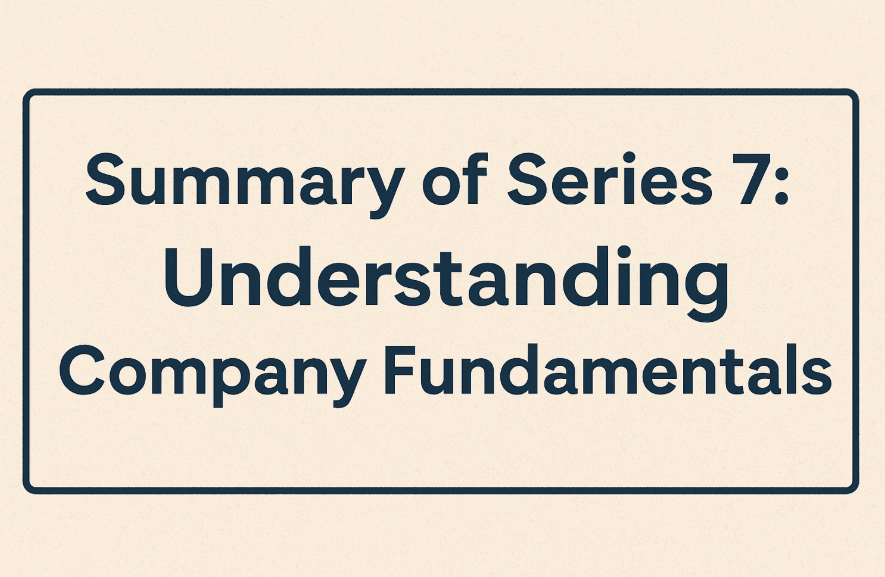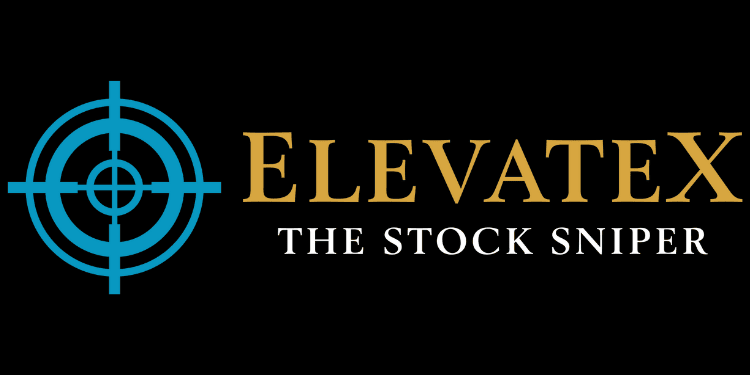- Live Life Grow Wealth
- Posts
- 📊 Summary of Series 7: Understanding Company Fundamentals
📊 Summary of Series 7: Understanding Company Fundamentals

Today’s Headline
📊 Summary of Series 7: Understanding Company Fundamentals
A Complete 7-Day Recap to Help You Analyze Companies Like a Pro
Before you invest in any company, you must learn how to understand the business behind the stock. That was the main purpose of Series 7. Over the past seven days, we dug deep into what actually makes a company valuable, healthy, and worth investing in. This entire series was designed to help you think like a professional investor, even if you’re just getting started.
In this summary, I want to bring everything together and give you a clear, simple, big-picture understanding of what you’ve learned. By the time you finish reading this recap, you will have a full roadmap you can use every time you evaluate a stock.
💡 Your Portfolio Isn’t the Only Thing That Needs Optimization
Smart investors don’t just grow their wealth — they also streamline their business operations for maximum efficiency and profit.
If you're an entrepreneur, run a startup, or manage a growing team, this free HR software matching tool can save you hours and thousands of dollars by helping you pick the right HR tech — just like a financial advisor would help you pick the best ETF.
Get a List of the Best HRIS Software for Your Company
Stop wasting time on endless research and confusing options.
Our HR Software experts provide you with tailored recommendations from our database of 1,000+ vendors across HRIS, ATS, Payroll, and HCM.
✅ 15 minutes vs. hours of demos
✅ 1:1 help from an HR Software expert
✅ No spam, no sales pressure
Day 1: Understanding What Fundamental Analysis Really Is
We started the series by talking about fundamental analysis, the heart of long-term investing. I explained that fundamental analysis is about studying the real business behind the stock—not the price movement, not the hype, not what people say online. It’s about understanding how the company makes money, how strong its business model is, and whether it has the power to grow in the future.
Fundamental analysis helps you see the truth behind the numbers, and it gives you confidence during market volatility. If you know the business well enough, short-term ups and downs won’t scare you.
Day 2: The 3 Financial Statements Every Investor Must Know
On Day 2, we focused on the three main financial statements:
Income Statement (shows profit and revenue)
Balance Sheet (shows financial strength)
Cash Flow Statement (shows real money movement)
I explained how each report tells a different story about the company.
The income statement shows whether the business is growing.
The balance sheet shows whether it is strong or weak.
The cash flow statement shows whether the company can survive and keep operating.
Together, these three reports form the “health check” of any company.
Once you know how to read them, you can see things most investors overlook.
Day 3: Revenue, Profit Margins & Cash Flow — Why They Matter
On Day 3, we zoomed in on three key measurements that reveal how healthy a business truly is.
Revenue
This tells you if customers actually want what the company sells.
Profit Margins
This tells you how well the company manages costs and turns sales into profit. High margins show strong pricing power and operational efficiency.
Cash Flow
Cash flow is the most important because it tells you if the company truly generates real money. A business can report profits on paper but still run out of cash in real life.
We also talked about why cash flow protects companies during recessions, market crashes, and unexpected shocks. Healthy cash flow keeps a company alive.
Day 4: Key Ratios Every Investor Should Know
On Day 4, we broke down the most important ratios that help you compare companies quickly:
P/E Ratio (Price-to-Earnings)
This helps you understand if the stock is expensive or cheap.
ROE (Return on Equity)
This shows how well the company uses investors’ money to generate returns.
Debt-to-Equity Ratio
This reveals whether the company relies heavily on debt and how risky it is.
These ratios act like shortcuts. Instead of guessing, you can use numbers to check whether the company is efficient, profitable, and responsibly managed.
Day 5: Strong vs. Weak Balance Sheets
On Day 5, we focused entirely on financial strength.
A strong balance sheet usually includes:
Low debt
High cash reserves
Consistent assets
Low risk of bankruptcy
A weak balance sheet usually includes:
Heavy debt
Low or decreasing cash
Too many liabilities
Difficulty surviving downturns
I shared how strong balance sheets help companies survive recessions, market crashes, and high interest rate environments. In tough times, the strong get stronger, and the weak often collapse. Knowing how to spot the difference protects your long-term investments.
"Boost your investment strategy by unlocking the power of CTV advertising with Roku Ads Manager—learn how to maximize returns this holiday season. Click here to explore!"
Find your customers on Roku this Black Friday
As with any digital ad campaign, the important thing is to reach streaming audiences who will convert. To that end, Roku’s self-service Ads Manager stands ready with powerful segmentation and targeting options. After all, you know your customers, and we know our streaming audience.
Worried it’s too late to spin up new Black Friday creative? With Roku Ads Manager, you can easily import and augment existing creative assets from your social channels. We also have AI-assisted upscaling, so every ad is primed for CTV.
Once you’ve done this, then you can easily set up A/B tests to flight different creative variants and Black Friday offers. If you’re a Shopify brand, you can even run shoppable ads directly on-screen so viewers can purchase with just a click of their Roku remote.
Bonus: we’re gifting you $5K in ad credits when you spend your first $5K on Roku Ads Manager. Just sign up and use code GET5K. Terms apply.
Day 6: How to Value a Company — Simply Explained
On Day 6, we covered valuation techniques in the simplest way possible.
DCF (Discounted Cash Flow)
Helps estimate the company’s true value based on future cash flow.
P/E Valuation
Helps compare companies quickly by seeing how much investors pay for each dollar of profit.
Relative Valuation
Helps you check if the stock is overpriced or underpriced compared to similar companies.
The goal was not to turn you into a financial analyst overnight.
The goal was to let you understand whether a price is fair, high, or cheap.
You learned that a great company is not automatically a great investment—only a fairly priced one is.
Day 7: The Final Checklist Before Buying Any Stock
On the final day, we combined everything into one simple checklist. This checklist is something I personally use before buying any stock, and now you have the same tool.
It included points like:
Do you understand the business?
Does it make real profits?
Is the balance sheet strong?
Does it have a competitive advantage?
Is management competent and trustworthy?
Is the valuation fair or overpriced?
Are industry trends supportive?
What are the risks?
Does the stock fit your long-term strategy?
This checklist ensures you stay disciplined.
It stops emotional decisions.
And it helps you avoid messy mistakes.
How the Entire Series Comes Together
When you look at all seven days together, you can see the full picture:
Day 1 teaches how to think.
Days 2–6 teach what to look for.
Day 7 teaches how to make a final decision.
You now know how to:
Read financial statements
Evaluate revenue and profit strength
Compare companies using ratios
Spot strong vs. weak financials
Value a business properly
Judge management
Understand the industry
Manage risks
Decide with confidence
This is the foundation professional investors use.
And now you can use it too.
Final Takeaways
This series was meant to transform how you see the stock market.
Most people buy based on tips, hype, guesswork, or emotions.
But you now have a structured way to evaluate companies clearly.
You know how to look deeper.
You know how to read numbers.
You know how to judge strength vs. weakness.
You know how to make long-term decisions with confidence.
This is what separates smart investors from the crowd.
If you continue applying everything you’ve learned in Series 7, your investing decisions will feel clearer, calmer, and more deliberate. And over time, that discipline is what builds real wealth.
[Live Life Grow Wealth]
🎓 Free Masterclasses to Unlock Your Investment Potential
Take your money skills to the next level with expert-led workshops designed to help you grow smarter and faster.
Recommendations Section
“Peek into smart money moves — when big players act, you’re in the loop.”
|
Learn simple, proven ways to grow your money — straight from real investors who walk the talk.
|
“Hone your investing edge in just 5 minutes — smart, snappy insights to power your portfolio growth.”
|
“Stay ahead with one expert-picked stock monthly — clear, no jargon, built for growth.”
DISCLAIMER
I make no representations, warranties, or guarantees, whether expressed or implied, that the content provided is accurate, complete, or up-to-date. Past performance is not indicative nor a guarantee of future returns.
I am an individual content creator and not regulated or licensed by the Monetary Authority of Singapore (MAS) as I do not provide investment services.
All forms of investments carry risks, including the risk of losing your entire invested amount. Such activities may not be suitable for everyone. You are strongly encouraged to seek advice from a professional financial advisor if you have any doubts or concerns.







